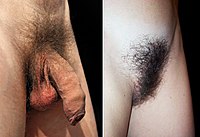
Photo from wikipedia
In recent years, increasing levels of precision of the cut surface characteristics in the cutting process of a metal die have become required not only for crack prevention but also… Click to show full abstract
In recent years, increasing levels of precision of the cut surface characteristics in the cutting process of a metal die have become required not only for crack prevention but also for die roll prevention. The conventional shaving die is unlikely to be applied to achieve these requirements. As an innovative design, a novel modified shaving die with two steps of tapering, press and cut tapers, was designed and proposed in this research. The finite element method (FEM) was used to clarify the cutting mechanism and identify the effects of the process parameters and geometry of the shaving die of interest on the cut surface characteristics based on material flow and stress distribution analyses. The press taper limits the die roll formation on the sheared edge during the first stage of the cutting phase, and the cut taper prevents a new die roll from forming during the second stage of the cutting phase. The results showed that by using the novel modified shaving die, die roll formation could be reduced. Furthermore, by suitably selecting the process parameters and geometry of the shaving die, nearly zero die roll (nZDR) could be achieved. Laboratory experiments were carried out to validate the FEM simulation results. The FEM simulation results showed good agreement with the experimental results in terms of the cut surface characteristics and the cutting forces.
Journal Title: International Journal of Precision Engineering and Manufacturing
Year Published: 2021
Link to full text (if available)
Share on Social Media: Sign Up to like & get
recommendations!